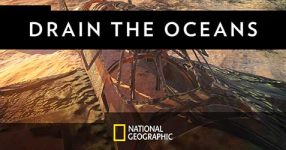The documentary “The City of Atlantis” delves into the enduring legend of Atlantis, a city rich in culture and technological advances that, according to legend, was submerged beneath the waves over eleven thousand years ago. This investigation, conducted by Naked Science, seeks to separate fact from fiction surrounding the mysterious disappearance of Atlantis.
The Search for Atlantis: Exploring Possible Sites
The quest for Atlantis takes the audience to various locations around the world, examining four potential sites for the watery grave of this ancient civilization. The journey begins with the shattered fragments of a Mediterranean island destroyed by a volcanic eruption 3,600 years ago, uncovering the remains of a once-thriving civilization that mysteriously vanished.
Continuing the exploration, the documentary shifts to the Caribbean, investigating underwater formations off the coasts of Cuba and the Bahamas. Along the way, the audience encounters both optimistic amateurs claiming to have found the lost city and serious researchers studying genuine archaeological mysteries. The central question lingers: if Atlantis did exist, where is it now?
Plato’s Clues: Unraveling the Ancient Greek Philosopher’s Account
To unravel the mystery of Atlantis, the documentary goes back to the origins of the legend, rooted in the writings of the ancient Greek philosopher Plato around 350 BC. Plato’s detailed description provides crucial clues, indicating Atlantis as a vast city laid out in concentric circles, built with red, black, and white rocks, and featuring peculiarities like bull sacrifices and pyramid-like structures.
However, before embarking on the search, the documentary questions the feasibility of an entire civilization being annihilated by a single catastrophic event, as Plato suggested. Examining natural disasters throughout history, from earthquakes to tsunamis, the narrative highlights the potential for such cataclysms and their destructive force on civilizations.
Potential Sites: Malta, America, Bahamas, and Santorini
The exploration of potential Atlantis sites leads to Malta, where magnificent megalithic temples stand as intriguing ruins. While evidence of animal sacrifices and submerged temples sparks interest, the absence of elephants poses a challenge to Malta’s claim as the true Atlantis.
The documentary then shifts its focus to the Americas, where a new-age obsession suggests Atlantis may lie. Examining the Bahamas, specifically the Bimini Road, and delving into the bizarre claims of psychic Edgar Cayce, the narrative explores the possibility of an ancient civilization wiped out by natural disasters, potentially from outer space.
Next, the investigation takes us to the waters off Cuba, where underwater structures with a layout reminiscent of ancient Mayan cities are discovered. The presence of regular-shaped rocks forming structures raises questions about whether these formations could be man-made and possibly linked to Atlantis.
The final contender in the search for Atlantis is Santorini, an island close to ancient Greece. Drawing parallels between Plato’s description and the circular outline of Santorini, the documentary explores the volcanic history of the region, including catastrophic events that wiped out advanced civilizations, such as the Minoans.
Conclusion: Atlantis Remains a Mystery
Despite the extensive exploration and analysis, the documentary “The City of Atlantis” concludes that Atlantis must remain a mystery. The experts involved express skepticism about bending historical facts to fit Plato’s narrative, emphasizing the need for concrete evidence. While Naked Science acknowledges the possibility of future archaeological discoveries in the world’s oceans, the elusive Atlantis continues to capture imaginations as an enduring myth.












